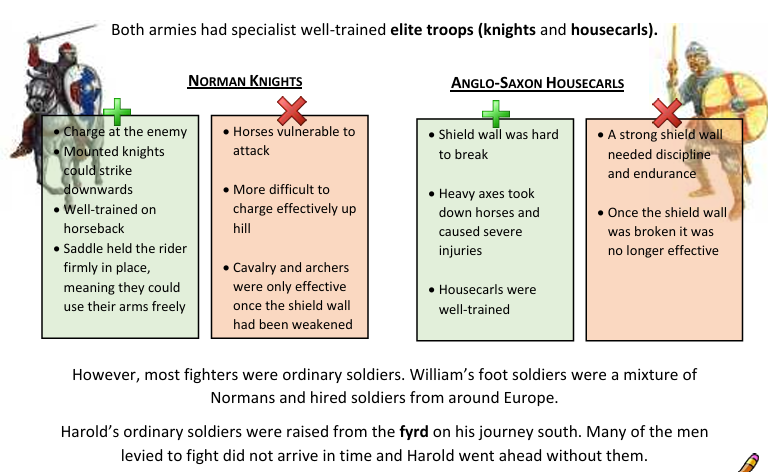Anglo Saxon times and Norman conquest : Theme 1 (copy)
1/39
There's no tags or description
Looks like no tags are added yet.
Name | Mastery | Learn | Test | Matching | Spaced |
|---|
No study sessions yet.
40 Terms
What was the population of England during Anglo-Saxon times?
About 2 million people—less than half the population of London today!
What was the main occupation of people in Anglo-Saxon England?
Almost everyone farmed land.
What role did religion play in Anglo-Saxon England?
England was a Christian country, and religion played a large role in everyday life.
What external threat had England faced for centuries during the Anglo-Saxon period?
England had been under threat from the Vikings, especially in the north where Viking settlers lived.
Who was Edward the Confessor and when did he rule?
Edward the Confessor was king from 1042 to 1066.
Who were the kings before Edward the Confessor?
King Cnut and his two sons, who were Vikings.
How was the government in Anglo-Saxon England described?
England had a very well-organised government.
The british social system from lowest to highest order
Slaves→Peasants→Thegns→Earls→King
Slaves
Slaves made up about 10% of the population, and were viewed more as property than people. Owning slaves was a normal part of life for the Anglo-Saxons, but the Normans thought it was cruel.
Peasants
Peasants made up most of the population. They worked for their local lord. Ceorls (“curls”) were free to go and work for another lord if they wanted to, although they still had to do some work for their local lord as well.
Thegns
Thegns (“thanes”) were local lords who lived in a manor house and held more than 5 hides of land. Thegns had a duty to provide men for the fyrd (army) when needed.
Earls
Earls were the most important men after the king. The area of the country controlled by an earl was called an earldom.
King
The king was the most powerful person in Anglo-Saxon England. His job was to protect his people from attack and make laws.
Movements made in the social class going up
-Peasants and merchants could work their way up to thegn status.
-Slaves could be freed by their masters to become ordinary peasants.
-Thegns could be promoted to earls.
Movements made in the social class going down
-A peasant could sell themselves into slavery to support their family.
-An earl could be demoted to a thegn.
Edward the Confessor
was king from 1042 to 1066. Every boy swore an oath to the king when they reached 12 years old. The king controlled law-making, money, land ownership, the military and taxation.
Edward’s strengths
- A powerful king was one who had success in battle and led a strong army.
- Edward was not a warrior king himself, but his earls and thegns were a powerful military force.
- He was a respected law maker – someone who kept things peaceful.
-He was pious (very religious). Kings claimed to have a special link to God.
Limits to Edward’s power
-Half of the country, the Danelaw, still had strong Danish links from previous Viking invasions. These people wanted to live by their own laws and customs.
- The Earl of Wessex, Earl Godwin, was very powerful. He could put pressure on Edward to do things his way.
-Edward and Godwin fell out in 1050. Edward forced Godwin into exile, but he returned in 1051 with an army, and Edward gave him his earldom back to prevent a war.
The Witan
The Witan was a council of powerful advisers to the king, including earls and archbishops. It discussed threats, settled disputes, and played a key role in choosing a new king. However, the king chose its members, decided when it met, and was not required to follow its advice.
Earldoms
The earls were given many of the king’s powers in order to help run the country.
- They collected taxes. Earls kept a third of what they collected, so were very rich.
-They were in charge of justice and legal punishments in their earldom.
- They had great military power. Each earl had a group of highly trained bodyguard soldiers called housecarls.
Earls depended on the support of the thegns in their earldom.
Fyrd
The fyrd was the army, made up of one man from every five hides.
Select Fyrd
The select fyrd was made up of well-equipped thegns and their followers. Their service was fixed at a period of 40 days, because they couldn’t leave their farms for too long.
Shire reeves
They collected fines, enforced the law, provided men for the fyrd and maintained roads and defences.
They also collected the geld tax. This was a tax on land originally to pay off the Vikings.
Local government
The country was divided into earldoms, controlled by an earl.
Each earldom was divided into shires, overseen by a shire reeve.
Each shire was divided into hundreds (equal to 100 hides in some areas).
Each hundred was divided into tithings (groups of 10 households).
A hide was a measurement of land equal to about 120 acres.
The legal system
Justice was based on collective responsibility – if someone refused to join the fyrd, there would be consequences for the whole tithing.
Blood feuds were grudges between families which often lasted generations. If someone was killed, the victim’s family had the right to kill someone from the murderer’s family.
The Wergild system meant that instead of taking revenge, the victim’s family received compensation from the murderer’s family. A ceorl was worth 20 shillings, a thegn 1200 shillings and an earl or archbishop 3600 shillings.
The economy
England was well suited to growing crops, and likely traded wool and cloth too. The Anglo Saxons traded with other countries (e.g. silver for coins came from Germany).
The biggest cities were London and York, and important towns included Norwich and Lincoln.
Each shire had a main town called a burh. These were well fortified and linked by roads. The king’s laws said that more valuable trade had to take place in a burh, so that trade tax could be paid.
Villages consisted of a few houses scattered in the countryside. Houses were made of wood and straw. Lots of relatives lived together. Thegns also lived in the countryside, but their houses were bigger and better-built than peasant huts.
The Influence of the Church
- The English Church was organised into large areas controlled by bishops, who were rich, important people.
-Local priests were often quite ordinary people and not especially well-educated.
- Abbots and abbesses ran monasteries and nunneries, though the number of these was shrinking.
- Religion was an important part of everyday life because people worried about what would happen when they died. For example, Edward devoted time to rebuilding Westminster Cathedral.
Edward the Confessor’s Last Years : The Godwin Family
Earl Godwin had been made Earl of Wessex by King Cnut in 1018. Godwin helped Edward the Confessor become king, and Edward was married to Godwin’s daughter Edith.
The Godwins’ strength would help England against any Viking invasion, but it also weakened the king’s power.

Why were the Godwins so powerful?

Harold’s Embassy to Normandy
Harold Godwinson went to Normandy on a mission for the King (an embassy) in 1064.
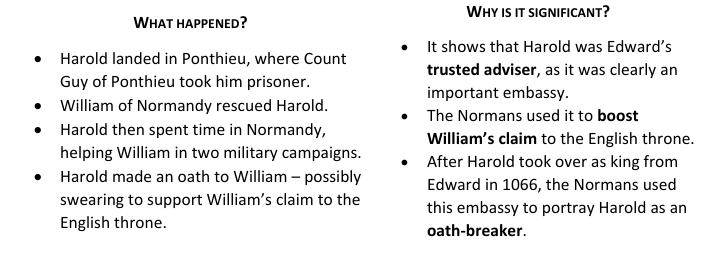
The Rising Against Earl Tostig
In 1065 there was an uprising against Tostig, the Earl of Northumbria. It was led by important Northumbrian thegns. The rebels invited Morcar, brother of the Earl of Mercia, to be their earl. Harold Godwinson’s second wife was Morcar’s sister, Edith of Mercia. Harold was given large amounts of land in Mercia. By November 1065 Tostig was exiled.
Edward was old and ill by this point, and Harold wanted to be king. By getting rid of his brother, he removed a potential rival for the throne.

Edward the Confessor’s Death
Edward died on the 5th of January 1066. He had no children, which meant there was a succession crisis. The Bayeux Tapestry shows Edward on his deathbed, holding out his hand to Harold. The Witan met quickly and Harold was crowned the same day as Edward’s burial, 6th January 1066.
1066 & the Rival Claimants for the Throne
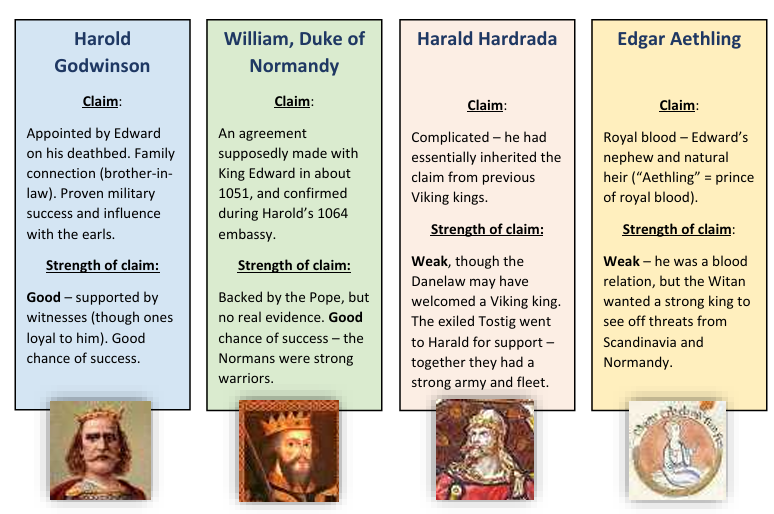
Harold’s Coronation and Reign
Harold was crowned quickly because the Witan feared an attack by William. He faced several challenges as king:
-Challenges from powerful earls - including old rival the Earl of Mercia
- The north – would they accept Tostig’s brother as their new king?
- Tostig – was looking for allies in Europe
- William – was reportedly getting ready to invade
Harold met with other Witan members at York, Northumbria’s main city, to get their support.
He positioned an army along the south coast, expecting an invasion attempt by William. They eventually stood down when the Norman invasion had still not come by September.
Tostig sailed to England in May 1066, but he was put off by Harold’s strong defences. A fight with the Mercians at Lincoln left him with only 12 ships.
Battle #1 : The Battle of Gate Fulford – 20th September 1066
Harald Hardrada and Tostig attacked in September 1066. They were blocked just outside York by the new Earl of Northumbria Morcar and his brother Edwin (Earl of Mercia) at Gate Fulford.
The battle was a defeat for Morcar and Edwin. Their mistake was fighting just outside York, rather than within the city walls.
Harold heard about the invasion and marched north. He must have been confident that William would not attack the south any time soon.
Battle #2 : The Battle of Stamford Bridge – 25th September 1066
Harold surprised Hardrada and Tostig at Stamford Bridge. Both Hardrada and Tostig were killed. Harold won because:
-The Vikings had left their armour on their ships
- He had the element of surprise
- Hardrada and Tostig had fought at Gate Fulford 5 days before
- The Vikings were (wrongly) under the impression that the English hated Harold
- Harold’s men broke the Viking shield wall
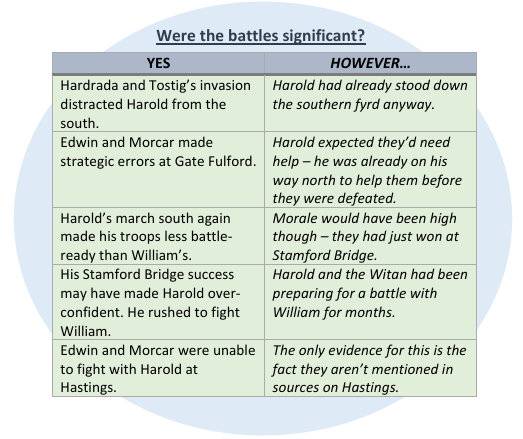
1066

The Norman Invasion : Battle #3 : The Battle of Hastings – 14th October 1066
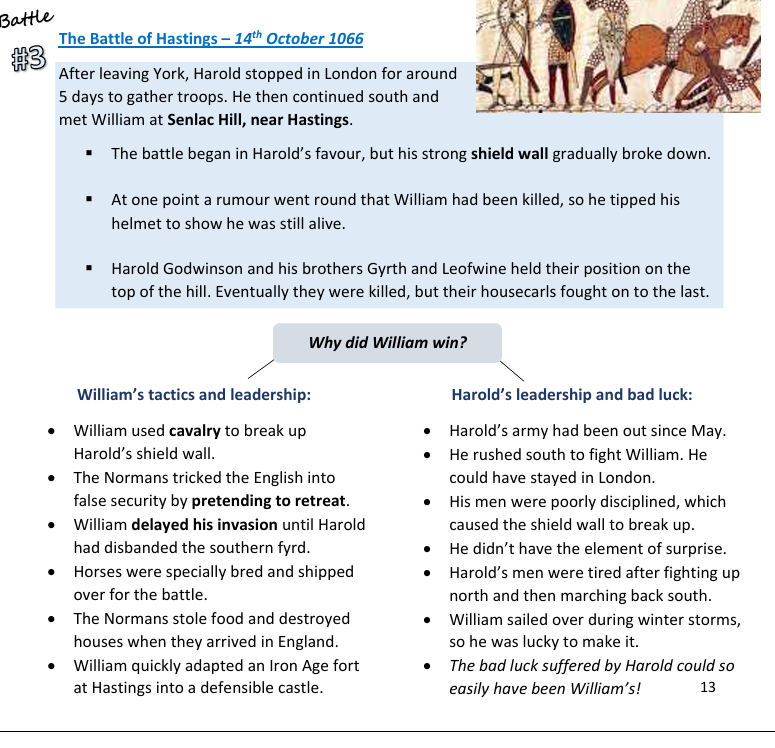
The Norman Invasion : Elite troups
